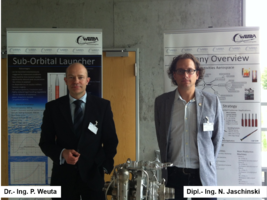
September 2015
WEPA-Technologies did visit ”Pico- and Nano-Satellite Conference 2015” in Würzburg / Germany (09/15 – 09/16) (http://www7.informatik.uni-wuerzburg.de/conferences/pina2015/) .
The biannual conference has been well attended – a broad range of topics covering various aspects of development and use of small satellites has been covered in the presentations (program overview):
CEO Dr. Weuta gave a presentation about current developments at WEPA-Technologies in the field of Low Cost Suborbital Rockets (“Development of a Low Cost Suborbital Rocket for Small Satellite testing and In-Space experiments”). The payload assumed in this study has been of TEXUS-class (DLR / ESA): 400 kg @ 300 km
(The extended presentation can be downloaded below.)
PDF-Dokument [1.0 MB]
Abstract:
Development of a Low Cost Suborbital Rocket for Small Satellite testing and In-Space experiments
Authors: Dr.-Ing. Peter H. Weuta, Dipl.-Ing. Neil Jaschinski
WEPA-Technologies GmbH
Delivery of small satellites into LEO has a long lead time and comes along with very significant costs. Therefore functional reliability of satellites has to be very high once they are delivered to orbit. While many features of the satellites can be optimized on the ground, qualification in space is a major precondition to lead to a truly reliable product.
A low cost suborbital rocket to deliver experimental payloads to space for short duration tests is considered to be very helpful to support development of small satellites and conduct in space- and zero gravity research.
We present the out-line of a sounding rocket, a system with simple and cost effective design, high reliability and use of ‚green propellants’. An overview of the subsystems technology under development at WEPA-Technologies will also be given. The maximum height will be around 300 km, therefore enabling a multitude of different tests and experiments to be conducted.
The goal of the activities described is to finally offer frequent opportunities to the Nano- and Micro-Satellite community to prequalify their technologies during suborbital flights.
The sounding rocket under development is propelled by a turbo pump driven, liquid propellant rocket engine using hydrogen peroxide (H2O2, 90 – 95 %) and kerosene.
Low cost character will be realized by multiple, parallel approaches:
1) simplified design of propulsion system (rocket engines and turbo pumps)
2) low-level operational parameters (engine chamber pressure)
3) use of low-cost materials and manufacturing technologies
4) environmentally benign and easy to handle propellant components (H2O2 / Kerosin)
During transport and payload integration the fuel tanks are completely empty and the whole system safe to handle. In contrast to the traditional use of solid propellant rocket engines, no stringent safety measures are required.
After the rocket is fuelled, launch readiness can be kept up for many weeks. Therefore a responsive launch after occurrence of a e.g. special atmospheric condition worth to be examined can be conducted.
As a consequence of the very low complexity ground support equipment required, launch sites can be chosen very flexible.
Characteristics of key technologies required are outlined. Besides the propulsion unit, this encompasses a system to produce concentrated H2O2 (90 – 95 %) at the launch site.
WEPA-Technologies GmbH has been founded in 2011 to provide development and manufacturing solutions in the field of Aerospace, Engineering and Automation. An extensive range of manufacturing technologies is available at the company owned workshop facility. Prototyping therefore can be realized in house.

